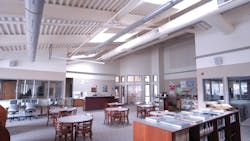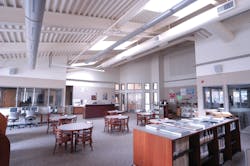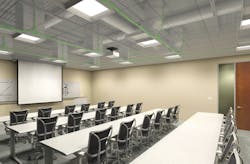Today’s high-performance school buildings should take advantage of daylighting. Daylight harvesting includes skylights and tubular daylighting devices combined with sensors tied to dimmable lights, as well as south-facing windows with light shelves to bounce light onto the ceiling and automated window shades.
Harvesting daylight offers a multitude of benefits beyond energy savings. It is the highest-quality light source available for interior environments, it is flicker-free, and it provides excellent color rendering and color balance. Skylights and daylighting tubular devices reduce cooling costs because less reliance on electric lights means less heat is generated. And daylighting is one of the fastest greenhouse gas-reducing paybacks schools can buy, because it shrinks both energy bills and re-lamping maintenance costs. Introducing daylight into buildings provides energy savings, excellent lighting quality and more beautiful interior spaces.
Gaining momentum
So why don’t more buildings in the United States harvest daylight as a light source? According to a forthcoming study by Eneref Institute (eneref.org), a group that conducts sustainability research, that is about to change. Expect to see more daylighting—especially skylights and tubular daylighting devices—specified for new construction and renovations, as well as for lighting retrofits.
Plenty of evidence points to daylighting’s role in improving occupant productivity in both schools and offices. Especially in learning environments, skylighted classrooms provide a natural and stimulating space for teachers and students.
Studies show that poor lighting adversely affects learning; effectively designed daylighting has been shown to increase student performance in math and reading scores, and improve attendance.
For students, daylighted rooms that offer the right amount of light for the task at hand improve visibility and visual comfort. For teachers, daylight can enhance learning activities through improved student moods and concentration, and reduce off-task behavior. Administrators will see improved student and teaching outcomes, a lower energy and maintenance burden, and better compliance with code standards.
Some educational investments are paid back in ways not always measured in dollars; daylighting, used in conjunction with control systems, can provide a rapid return on investment. Schools illuminated with natural light are able to keep electric lights turned off for the majority of the school day. To realize the energy savings, the electric lights must be turned off or dimmed when the sun is shining. This is best done automatically by controls that sense sunlight levels and adjust electric light levels accordingly.
Energy benefit
Lighting accounts for roughly one-third of electricity used by commercial or education facilities in the United States.
As departing U.S. Energy Secretary Steven Chu says, “Energy efficiency isn’t just low-hanging fruit; it’s fruit lying on the ground.”
Daylighting is especially efficient compared with, say, photovoltaic (PV) cells. PV panels collect sunlight to generate electricity and then the electricity is converted back into light by way of fluorescent or LED lamps.
Daylighting simply harvests the sunlight directly. And a well-designed system will be able to bring most of the daylight captured on the roof into classrooms. Daylighting is about 10 times more efficient then rooftop PV cells for lighting a room.
Put another way, skylights need only one-tenth of the roof space to produce the same amount of light as PV panels need to generate the electricity to power the light fixtures.
Already, many utilities charge much higher rates during peak demand periods—the very time that daylighting works best.
Trend in the market
Facilities with open or drop ceilings are perfect for daylighting. Depending on the cost of energy, systems can offer a five-year return on investment or less. After the payback period, it’s like money in the bank.
A well-designed system is one that adjusts and shuts off electric lights when the sun is sufficient to illuminate the space. It also should maximize the amount of daylight delivered into the space without glare. Maximizing daylight means bringing in the maximum amount of sun rays from the rooftop into the space interior with the least amount of daylight loss.
Productivity gains
The human productivity gains from daylight harvesting are significant. It has been shown to raise morale, increase productivity among students and workers, decrease product defects in numerous industries, and even increase retail sales. The human performance numbers in daylighting systems are important because the return on investment for daylighting sometimes can be a difficult sell. In fact, the human performance gains may outweigh the energy savings, as shown in cases where human performance can be measured in financial terms.
According to Heschong Mahone (HGM), a daylighting consulting firm, studies for Pacific Gas and Electric found positive results from daylighting in elementary student test scores. The study surveyed the performance of students of schools in Seattle; Fort Collins, Colo.; and Capistrano, Calif. It found that students in classrooms with more daylight tested higher or progressed faster. In a follow-up study, the researchers found that students with the most daylighting in their classrooms progressed 21 percent faster on math and reading tests compared with those in classrooms with no daylight.
Architectural design
The fastest, easiest way to bring daylight into an existing building is with a skylight or tubular daylighting device. A well-designed system can capture low-angle sunlight—capturing daylighting for more hours—and uses adjustable elbows to bypass obstructions and transport the sun’s rays through the building—typically via a 98-percent-reflective specular material. Look for systems that incorporate integrated light-controlling louvers and diffusers to maintain optimum foot-candles. Electric lights should include a dimming-control system to supplement the daylight. Both skylights and tubular daylighting devices should be designed optically to complement the LED or fluorescent fixtures and provide a seamless transition between light sources.
A high-performance prismatic lens will optimize light levels and eliminate unwanted glare and hotspots by diffusing the light. A prismatic lens also will mitigate damage from ultraviolet rays.
Sidebar: Tubular daylighting system leads school into natural light
“Overall it’s great—the kids definitely enjoy having natural light in there,” says William Teal about the sunlight streaming through the ceiling of his science classroom. “It’s just a much more natural feel.”
Teal, a science teacher with Alvin Junior High School in Alvin, Texas, has benefited from having his classroom retrofitted with rooftop tubular daylighting devices.
The teacher appreciates the look and feel of the new daylighting system, but Teal really was sold on the system after a Texas-sized thunderstorm knocked out a transformer and left the school without electricity. The entire school went dark except for Teal’s classroom. In fact, the rooftop daylighting system is even “high-velocity hurricane zone” approved.
“Lightning struck the transformer and the lights went out,” says Teal. “We had enough light in my room—still with it being overcast. My kids kept working.”
CMTA, a materials and process engineering firm, helped Alvin Junior High test the retrofit of the tubular daylighting device in Teal’s science classroom.
Initially, six tubular daylighting devices were retrofitted in the Alvin Junior High School science lab. To achieve a glare-free room, the devices use a prismatic pattern and lens layering. On the roof is an optic sphere designed to evenly distribute the sunlight coming in and drive it down into a lightwell made of a highly reflective aluminum.
In addition to installing tubular daylighting in the science room, CMTA replaced the existing controls and fluorescent T8s and a low-voltage control system. To bypass any obstructions between the roof and the suspended ceiling, the system has adjustable elbows that can angle the light rays. Light-controlling louvers adjusted the exact amount of daylight entering the room.
CMTA matched the prismatic lenses on the daylighting system with those on the lab’s fluorescent fixtures to ensure a uniform appearance. An automatic dimming system was installed on the fluorescent fixtures to adjust the fluorescent light output to the amount of daylight entering the room. The system’s optically designed diffusers complement the light distribution aesthetics of the fluorescent fixtures.
Typically in a classroom environment with artificial light alone—for example, at night with no available sunlight—CMTA looks to achieve 45 footcandles or greater in classroom environments. And depending upon where in the science room light readings were taken, 45 footcandles is approximately where the room ended up even with minimal help from the electric light source. Directly under a skylight, with just one electric light dimmed down to the lowest level, the measurements read exactly 45 foot-candles. On the same spot with the electric lights completely off, the light measured 42 foot-candles at desk level on the day the readings were taken. The lowest automatic dimming threshold point for the fluorescent lights may be reset to increase or decrease the footcandles coming from the electric lights based on users’ preferences.
Rose is the founder of the Eneref Institute, Doylestown, Pa., a research and advocacy organization for sustainable development.


